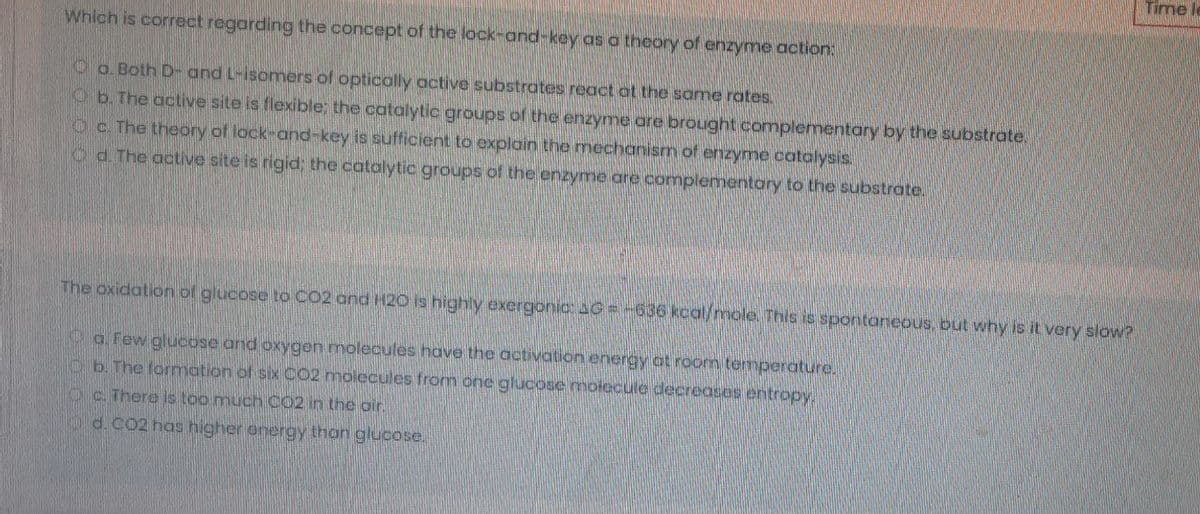Time Which is correct regarding the concept of the lock-and-key as a theory of enzyme action: O a. Both D- and L-isomers of optically active substrates react ot the same rates. O b. The active site is flexible; the catalytic groups of the enzyme are brought complementary by the substrate. OC. The theory of lock-and-key is sufficient to explain the mechanism of enzyme catalysis. Od. The active site is rigid; the catalytic groups of the enzyme are complementary to the substrate. The oxidation of glucose to CO2 and H20 is highly exergonic: AG = 636 kcal/mole, This is spontaneous, but why is it very slow? a. Few glucose and oxygen molecules have the activation energy at room temperature. b. The formation of six CO2 molecules from one glucose molecule decreases entropy, OC. There is too much CO2 in the air. d. CO2 has higher energy than glucose.
Time Which is correct regarding the concept of the lock-and-key as a theory of enzyme action: O a. Both D- and L-isomers of optically active substrates react ot the same rates. O b. The active site is flexible; the catalytic groups of the enzyme are brought complementary by the substrate. OC. The theory of lock-and-key is sufficient to explain the mechanism of enzyme catalysis. Od. The active site is rigid; the catalytic groups of the enzyme are complementary to the substrate. The oxidation of glucose to CO2 and H20 is highly exergonic: AG = 636 kcal/mole, This is spontaneous, but why is it very slow? a. Few glucose and oxygen molecules have the activation energy at room temperature. b. The formation of six CO2 molecules from one glucose molecule decreases entropy, OC. There is too much CO2 in the air. d. CO2 has higher energy than glucose.
Biology: The Dynamic Science (MindTap Course List)
4th Edition
ISBN:9781305389892
Author:Peter J. Russell, Paul E. Hertz, Beverly McMillan
Publisher:Peter J. Russell, Paul E. Hertz, Beverly McMillan
Chapter6: Energy, Enzymes, And Biological Reactions
Section: Chapter Questions
Problem 7TYK: In an enzymatic reaction: a. the enzyme leaves the reaction chemically unchanged. b. if the enzyme...
Related questions
Question
I need the answer as soon as possible

Transcribed Image Text:Time le
Which is correct regarding the concept of the lock-and-key as o theory of enzyme action:
O o. Both D- and L-isomers of optically active substrates react ot the same rates.
Ob. The active site is flexible; the catalytic groups of the enzyme are brought complementary by the substrate.
OC. The theory of lock-and-key is sufficient to explain the mechanism of enzyme catalysis
Od. The active site is rigid; the catalytic groups of the enzyme are complementary to the substrate.
The oxidation of glucose to CO2 and H20 is highly exergonic:AG = -636 kcal/mole. This is spontaneous, but why is it very slow?
O a. Few glucose and oxygen molecules have the activation energy ot room temperature.
O b. The formation of six CO2 molecules from one glucose molecule decreases entropy.
O C. There is too much CO2 in the or.
Od. CO2 has higher energy than glucose.
Expert Solution
This question has been solved!
Explore an expertly crafted, step-by-step solution for a thorough understanding of key concepts.
Step by step
Solved in 2 steps

Knowledge Booster
Learn more about
Need a deep-dive on the concept behind this application? Look no further. Learn more about this topic, biochemistry and related others by exploring similar questions and additional content below.Recommended textbooks for you

Biology: The Dynamic Science (MindTap Course List)
Biology
ISBN:
9781305389892
Author:
Peter J. Russell, Paul E. Hertz, Beverly McMillan
Publisher:
Cengage Learning

Biochemistry
Biochemistry
ISBN:
9781305577206
Author:
Reginald H. Garrett, Charles M. Grisham
Publisher:
Cengage Learning

Biology: The Dynamic Science (MindTap Course List)
Biology
ISBN:
9781305389892
Author:
Peter J. Russell, Paul E. Hertz, Beverly McMillan
Publisher:
Cengage Learning

Biochemistry
Biochemistry
ISBN:
9781305577206
Author:
Reginald H. Garrett, Charles M. Grisham
Publisher:
Cengage Learning